Bracken-fern poisoning in horses
Learn how to recognize bracken fern in pastures and the signs of bracken fern poisoning in horses.
ISSN 1198-712X, Published October 2009
Introduction
Bracken fern (Pteridium aquilinum) (Figure 1) is one of the most widespread species of vascular plants, exceeded in geographic range only by a few annual weeds (1). Bracken fern does not require high levels of water and can grow in a variety of conditions, unlike other ferns (1). Sandy soils in open woodlots, pastures and along roadsides are ideal places for sustainable growth. In monogastric (single-stomach) animals, such as horses, toxicity is related to the enzyme thiaminase (2). In ruminants, such as cattle, bone-marrow depression leads to an acute hemorrhagic syndrome (3).
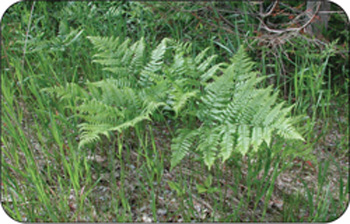
Figure 1. Bracken fern can grow in a variety of conditions, unlike other ferns.
In horses, thiaminase splits the essential vitamin thiamine (B1) into pyrimidine and thiazole, which individually are inactive in the body (2). Thiamine, as a whole, is a crucial compound in metabolism, and in maintaining the myelin of peripheral nerves (4). In the presence of thiaminase, blood thiamine levels in horses can decrease from a normal 80-100 mg/L to 25-30 µg/L (4). However, toxicity is directly affected by the quantity, the time of year and the part of the plant that is consumed (4). The rhizomes and young fronds are the most toxic. The fronds are most toxic during the rapid-growth phase (3).
Consumption of bracken fern on pasture is usually limited by horses' preference and the abundance of other palatable plants. The majority of clinical cases are related to the feeding of poor-quality hay that contains high levels of the fern. Bracken fern becomes incorporated in the hay when it invades hayfields from adjacent bush lots and roadsides. Signs of thiamine deficiency occur when hay containing bracken fern at 10%-20%, or more, of the horse's dry-matter intake is fed for approximately 4 weeks (1). For the average 454-kg (1,000-lb) horse, 1-2 kg (2.2-4.5 lb) of bracken fern would have to be consumed each day for a minimum of a month.
Clinical Signs
Thiamine deficiency in monogastric animals and in the horse in particular is marked by loss of condition (a general scruffy physical appearance), weight loss (initially without a loss of appetite) and slightly uncoordinated movements (4, 5). If not treated, the disease may progress to a point where the horse displays a crouching stance and a loss of muscular control (such as twitches and tremors) (4, 5). The horse may become uneasy and nervous due to its inability to control muscle movement; it may lie down and not be able to get up (1, 4). Intoxication terminates in death, following convulsions, several days to several weeks after the onset of symptoms (4).
In ruminants, the acute hemorrhagic syndrome (loss of blood) is linked to the chemical ptaquiloside and chronic ingestion of bracken fern. The concentration of ptaquiloside in bracken fern is dependent on the geographic location of the plant (2). The acute hemorrhage and sudden death occurs as a result of bone-marrow depression with subsequent thrombocytopenia (the condition of having a low platelet count) and increased tendency to bleed (4).
Poisonings in animals are uncommon since:
- it takes 1-3 months for the toxic effects to accumulate.
- there is variation in susceptibility of animal species.
- large quantities of dry matter must be consumed.
- toxicity depends on geographical location and time of year (since newly emerged fiddleheads are five times as toxic as mature fronds) (2).
Acute poisonings are seen after periods of drought when grazing is scarce or when a field is ploughed and animals have access to the rhizomes (3). Poisonings are most evident with stabled animals and when bracken fern is a major contaminant of hay (4).
Treatment
Early identification of the symptoms is critical in the treatment of bracken-fern poisoning. If caught early, simply removing the source of the fern will lead to a full recovery. Treatment with thiamine is occasionally needed. Treatment regimes or methods vary, depending on the author. One recommendation is to administer thiamine (vitamin B1) at 500 mg-1 gm/day - on day 1 intravenously and then intramuscularly for several days (1). The best method of prevention is to maintain good pastures, eliminate bracken fern from fields and ensure that bracken fern is not present in hay.
Identifying Bracken Fern
Bracken fern, unlike other fern species, favours dry, well-drained, sandy and gravely soils, such as open woodlots, pastures and roadside environments. They are herbaceous, perennial plants that emerge from the ground as curled fiddleheads. The fiddlehead opens into a compound leaf or frond, which appears to have three major divisions due to the stem branching to expose three leaflets. Each leaflet is about 30-140 cm long, 30-100 cm broad and triangular in shape (6). Projecting from the main fronds are distinctively lobed sub-leaflets that house the spores of the fern. In the late summer, the leaflets curl under to protect the brown-coloured, reproductive spores that are characteristically present along the perimeter of the underside of each leaflet (5). Like most ferns, bracken fern has modified underground stems called rhizomes that grow laterally and from which numerous above-ground stems emerge. The rhizomes of bracken fern are black and can grow horizontally for several metres (5). These persistent rhizomes, as well as sexually produced spores, make these ferns difficult to eradicate.
Control
Due to the plant's rhizomatous rooting system and its ability to produce mass amounts of spores, control and spread of bracken fern can be difficult. Growth can be slowed over time by regular cutting of the mature plant or by deep ploughing (1). Herbicide may also be an effective control if teamed with close cutting to encourage vegetative growth before a treatment is applied (1).
Ferns Commonly Found in Ontario
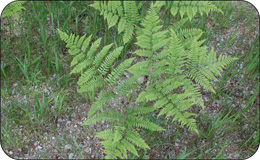

Bracken Fern (Pteridium aquilinum)
The leaves are compound and each leaf branches into 3 broadly triangular leaflets (7). One of the main distinguishing factors of bracken fern is how the sub-leaflets are lobed at the base but not the tip (right photo).
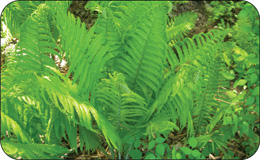
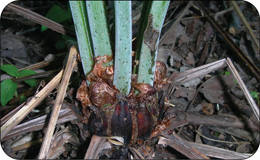
Ostrich Fern (Matteuccia struthiopteris)
The leaves are ostrich-plume shaped (oblong and pointed at the tip) and about 1.5 m tall (7), branching up directly from a scaly bulbous rhizome. A separate spore-producing structure developing from the rhizome looks like a stem that did not develop and browned. What appear to be folded leaves are pod-like structures housing the spores (7).
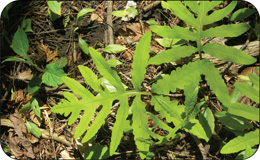
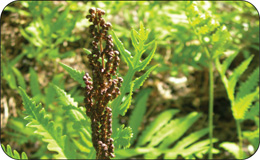
Sensitive Fern (Onoclea sensibilis)
These ferns are typically found in moist areas. The leaves are about 50-70 cm tall, and the leaflets are much wider, with very shallow lobing along the edges, making a wavy appearance (7). A separate dark-brown, spore-bearing, fertile structure has rolled bead-like clusters around the spores (7).
Consumption of sensitive fern at 10%-20% of the hay content also produces symptoms similar to that of thiaminase-related poisoning seen with bracken fern and horsetail (1).
References
- Burrows GE, Tyrl RJ. Toxic Plants of North America. Ames, Iowa: Iowa State Press, 2001:415-422.
- Knight AP, Walter RG. A Guide to Plant Poisoning of Animals in North America. Jackson, Wyoming: Teton New Media, 2001:194-197, 222-224.
- Radostits OM, Gay CC, Blood DC, Hinchcliff KW. Veterinary Medicine, 9th ed. Edinburgh: W.B. Saunders Company Ltd., 2000:1556-1558, 1659.
- Bracken fern poisoning: Introduction. In: The Merck Veterinary Manual, 9th ed. Whitehouse Station, NJ: Merck & Co., Inc. and Merial Ltd., 2005. Accessed April 8, 2010.
- Kingsbury JM. Poisonous Plants of the United States and Canada. Englewood Cliffs, New Jersey: Prentice-Hall, Inc., 1964:105-108.
- Alex JF. Ontario Weeds, Publication 505. Toronto, Ontario: 1992:20.
- Chambers B, Legasy K, Bentley CV. Forest Plants of Central Ontario. Edmonton, Alberta: Lone Pine Publishing, 1996:341, 359, 361.